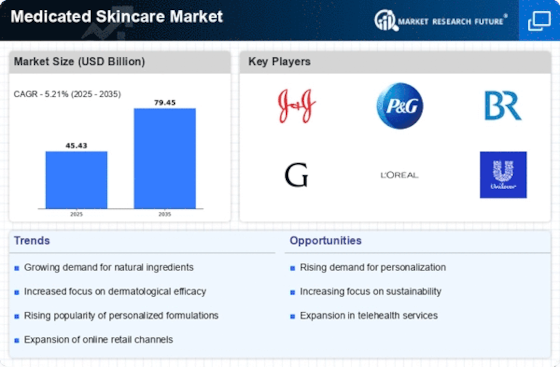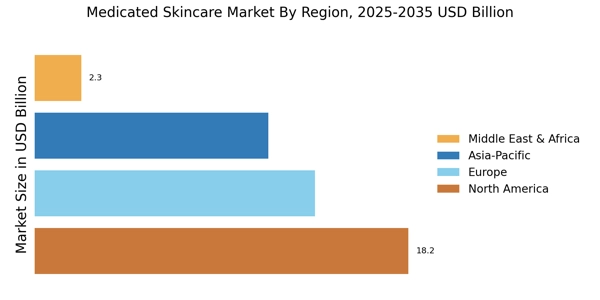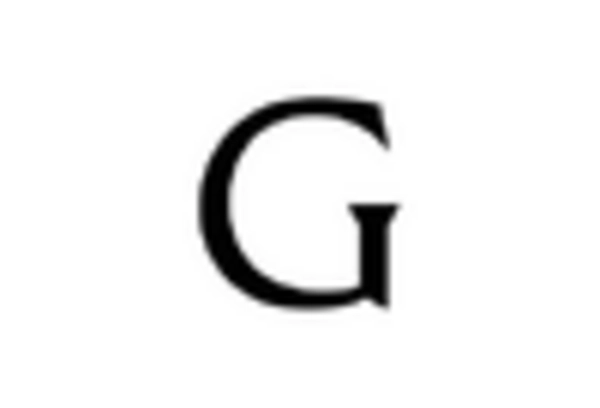Increased Consumer Awareness
Consumer awareness regarding skin health and the efficacy of medicated skincare products is on the rise, significantly influencing the Medicated Skincare Market. Educational campaigns and the proliferation of information through digital platforms have empowered consumers to make informed choices about their skincare. This heightened awareness has led to a shift in purchasing behavior, with more individuals opting for products that offer therapeutic benefits. Market data indicates that the demand for medicated skincare products has surged, as consumers increasingly prioritize ingredients that are clinically proven to be effective. This trend is expected to continue, as consumers become more discerning and seek out products that not only enhance appearance but also promote overall skin health, thereby driving growth in the Medicated Skincare Market.
Rising Incidence of Skin Disorders
The increasing prevalence of skin disorders such as acne, eczema, and psoriasis is a primary driver of the Medicated Skincare Market. According to recent data, approximately 50 million individuals in the United States experience acne annually, highlighting a substantial demand for effective treatment options. This trend is mirrored in various regions, where skin conditions are becoming more common due to factors like pollution and lifestyle changes. As consumers seek targeted solutions, the Medicated Skincare Market is likely to expand, with manufacturers focusing on developing innovative formulations that address specific skin concerns. The growing awareness of skin health and the importance of proper skincare regimens further contribute to this trend, suggesting a robust market potential for medicated products.
Advancements in Dermatological Research
Ongoing advancements in dermatological research are propelling innovation within the Medicated Skincare Market. New findings regarding skin biology and the mechanisms of various skin conditions have led to the development of more effective and targeted treatments. For instance, the introduction of biologics and other advanced therapies has transformed the landscape of skincare, offering new hope for individuals with chronic skin issues. As research continues to unveil new insights, the Medicated Skincare Market is likely to see an influx of novel products that cater to specific needs. This continuous evolution not only enhances treatment efficacy but also fosters consumer trust in medicated solutions, thereby expanding market opportunities.
Growing Popularity of E-commerce Platforms
The rise of e-commerce platforms is transforming the way consumers access medicated skincare products, significantly impacting the Medicated Skincare Market. Online shopping offers convenience and a wider selection of products, allowing consumers to explore various options without geographical limitations. Data suggests that e-commerce sales in the skincare sector have seen substantial growth, with many consumers preferring to purchase medicated products online due to the ease of comparison and access to reviews. This trend is expected to continue, as more brands enhance their online presence and invest in digital marketing strategies. Consequently, the Medicated Skincare Market is likely to benefit from increased visibility and accessibility, driving sales and fostering consumer engagement.
Regulatory Support for Skincare Innovations
Regulatory bodies are increasingly supportive of innovations in the Medicated Skincare Market, facilitating the introduction of new products. Streamlined approval processes for dermatological treatments and a focus on safety and efficacy have encouraged manufacturers to invest in research and development. This regulatory environment is conducive to the emergence of novel formulations that address unmet needs in the market. As a result, the Medicated Skincare Market is witnessing a surge in product launches, with companies eager to capitalize on the growing demand for effective skincare solutions. The collaboration between regulatory agencies and industry stakeholders is likely to foster a climate of innovation, ultimately benefiting consumers seeking advanced skincare options.


















Leave a Comment